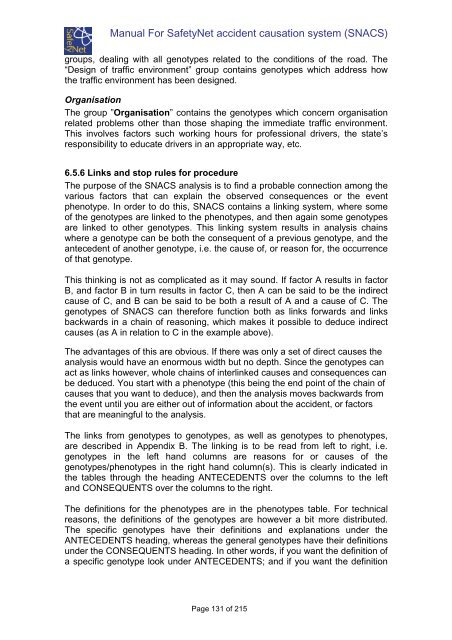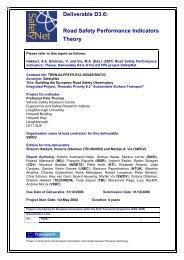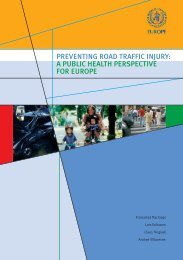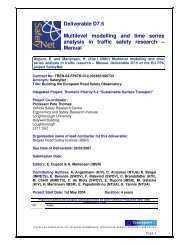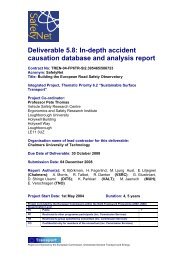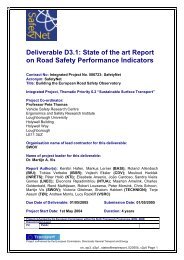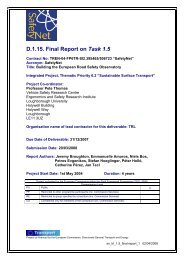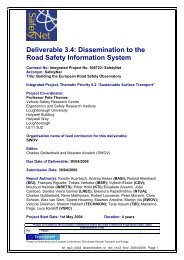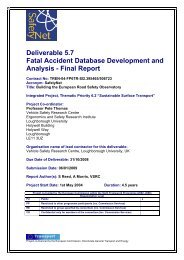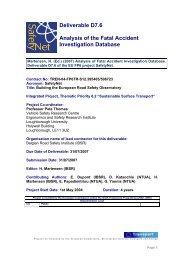Glossary of Data Variables for Fatal and accident causation ... - ERSO
Glossary of Data Variables for Fatal and accident causation ... - ERSO
Glossary of Data Variables for Fatal and accident causation ... - ERSO
You also want an ePaper? Increase the reach of your titles
YUMPU automatically turns print PDFs into web optimized ePapers that Google loves.
Manual For SafetyNet <strong>accident</strong> <strong>causation</strong> system (SNACS)<br />
groups, dealing with all genotypes related to the conditions <strong>of</strong> the road. The<br />
“Design <strong>of</strong> traffic environment” group contains genotypes which address how<br />
the traffic environment has been designed.<br />
Organisation<br />
The group ”Organisation” contains the genotypes which concern organisation<br />
related problems other than those shaping the immediate traffic environment.<br />
This involves factors such working hours <strong>for</strong> pr<strong>of</strong>essional drivers, the state’s<br />
responsibility to educate drivers in an appropriate way, etc.<br />
6.5.6 Links <strong>and</strong> stop rules <strong>for</strong> procedure<br />
The purpose <strong>of</strong> the SNACS analysis is to find a probable connection among the<br />
various factors that can explain the observed consequences or the event<br />
phenotype. In order to do this, SNACS contains a linking system, where some<br />
<strong>of</strong> the genotypes are linked to the phenotypes, <strong>and</strong> then again some genotypes<br />
are linked to other genotypes. This linking system results in analysis chains<br />
where a genotype can be both the consequent <strong>of</strong> a previous genotype, <strong>and</strong> the<br />
antecedent <strong>of</strong> another genotype, i.e. the cause <strong>of</strong>, or reason <strong>for</strong>, the occurrence<br />
<strong>of</strong> that genotype.<br />
This thinking is not as complicated as it may sound. If factor A results in factor<br />
B, <strong>and</strong> factor B in turn results in factor C, then A can be said to be the indirect<br />
cause <strong>of</strong> C, <strong>and</strong> B can be said to be both a result <strong>of</strong> A <strong>and</strong> a cause <strong>of</strong> C. The<br />
genotypes <strong>of</strong> SNACS can there<strong>for</strong>e function both as links <strong>for</strong>wards <strong>and</strong> links<br />
backwards in a chain <strong>of</strong> reasoning, which makes it possible to deduce indirect<br />
causes (as A in relation to C in the example above).<br />
The advantages <strong>of</strong> this are obvious. If there was only a set <strong>of</strong> direct causes the<br />
analysis would have an enormous width but no depth. Since the genotypes can<br />
act as links however, whole chains <strong>of</strong> interlinked causes <strong>and</strong> consequences can<br />
be deduced. You start with a phenotype (this being the end point <strong>of</strong> the chain <strong>of</strong><br />
causes that you want to deduce), <strong>and</strong> then the analysis moves backwards from<br />
the event until you are either out <strong>of</strong> in<strong>for</strong>mation about the <strong>accident</strong>, or factors<br />
that are meaningful to the analysis.<br />
The links from genotypes to genotypes, as well as genotypes to phenotypes,<br />
are described in Appendix B. The linking is to be read from left to right, i.e.<br />
genotypes in the left h<strong>and</strong> columns are reasons <strong>for</strong> or causes <strong>of</strong> the<br />
genotypes/phenotypes in the right h<strong>and</strong> column(s). This is clearly indicated in<br />
the tables through the heading ANTECEDENTS over the columns to the left<br />
<strong>and</strong> CONSEQUENTS over the columns to the right.<br />
The definitions <strong>for</strong> the phenotypes are in the phenotypes table. For technical<br />
reasons, the definitions <strong>of</strong> the genotypes are however a bit more distributed.<br />
The specific genotypes have their definitions <strong>and</strong> explanations under the<br />
ANTECEDENTS heading, whereas the general genotypes have their definitions<br />
under the CONSEQUENTS heading. In other words, if you want the definition <strong>of</strong><br />
a specific genotype look under ANTECEDENTS; <strong>and</strong> if you want the definition<br />
Page 131 <strong>of</strong> 215


